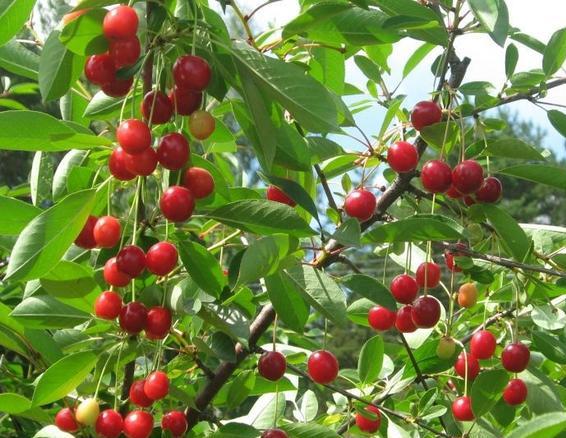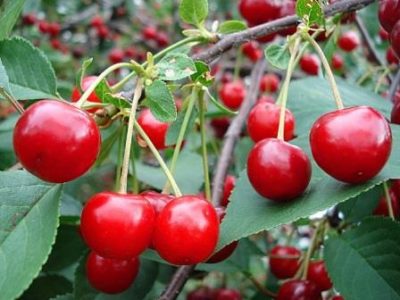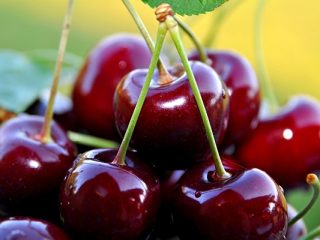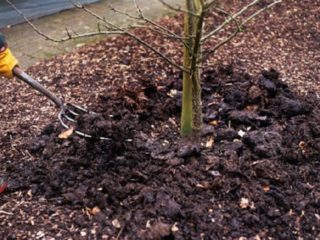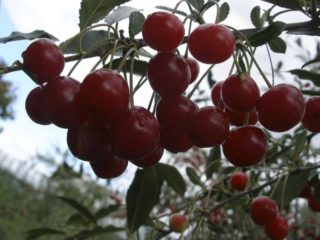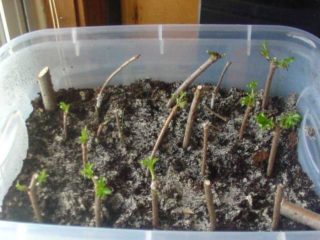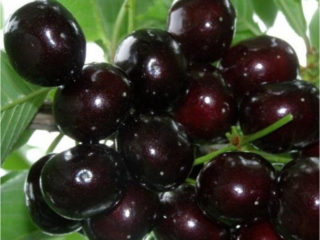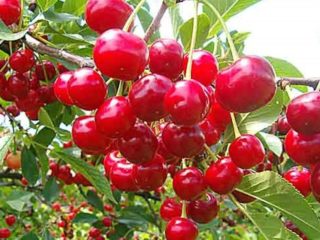Content
Each plant has its own characteristics of growing in a certain area. Properly planting cherries in the spring in the Urals in a zone of sharply continental climate is quite a difficult task. It is necessary to strictly follow agricultural technology, select the ideal place for the seedling and protect it from adverse weather conditions.
Features of growing cherries in the Urals
Fruit trees are found in most household plots throughout Russia. If in the central and southern regions of the country the climate is favorable for growing most crops, then in the Urals gardeners face a large number of problems. These most often include weather phenomena - droughts, frosts and early snowfalls.
A special feature of the Ural climate is cold winters and extremely hot summers. During the warm, dry months, it is important to provide the cherries with sufficient water in conditions of rapid evaporation of moisture. Tree trunk circles must be dug up 2-3 times a year to ensure better air flow to the roots.
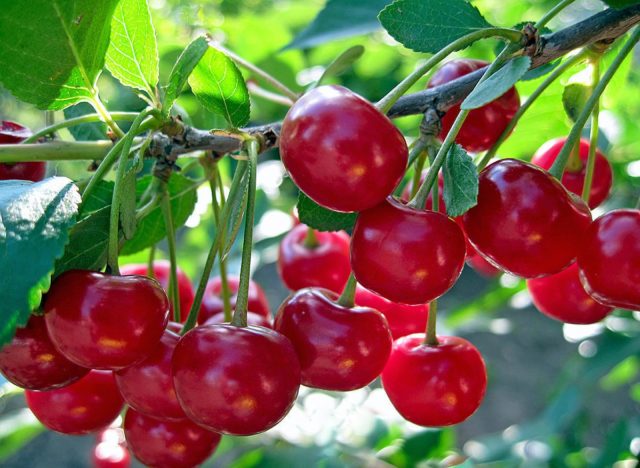
It is best to plant varieties specifically bred for growing in a given region.
Cherries are most often planted in the Urals in late spring or early summer. It only takes a few months for a young seedling to take root well and be ready for the winter. To plant a plant in the autumn, you need to insulate it as much as possible and hope for favorable conditions.
Every gardener in the Urals needs to pay attention to long-term weather forecasts. Cold winters with little snow can be disastrous even for the most frost-resistant varieties. In such conditions, it is very important to prepare the plant for winter - shelter it from the icy wind and treat the tree trunk circles with mulch.
How to choose a cherry variety for planting in the Urals
Every year modern breeding develops new types of fruit trees that are able to survive in difficult climatic conditions. For planting cherry seedlings in the Urals, it is best to select frost-resistant varieties. The most popular in the region include:
- Grebenskaya. This variety reaches a height of 2 m. It has sparse spreading branches. Flowering begins in May-June. From each cherry you can collect up to 8-10 kg of sweet berries, which ripen at the end of August.
- Sverdlovsk resident - a variety specially bred for the Urals. The height of the tree reaches 2 meters. The dense crown requires periodic thinning. The fruits have a sweet taste with a sour tint. The harvest reaches 10 kg from one cherry.
- Gridnevskaya. This species is considered one of the best adapted trees for a specific climate zone. It can withstand temperatures down to -35 degrees and short dry periods. The plant reaches a height of up to 2.5 m.Large sweet berries ripen towards the end of summer. Harvesting must be done as quickly as possible, since the berries, if suddenly damaged by cold, may lose their consumer characteristics.
- Ural standard. A feature of the variety is maximum productivity. From one small tree you can get up to 15 kg of large berries. Each fruit can reach 6.5 g.
All presented varieties can be planted throughout the Urals. They are able to withstand a sharp drop in temperature down to 30-35 degrees. Moreover, they were specially bred for accelerated harvesting in short summer conditions. It takes 1.5 to 2 months for the berries to fully ripen. However, their collection must be carried out as quickly as possible.
How to grow cherries in the Urals
Following clear instructions when planting fruit trees in continental climate zones will allow you to obtain healthy plants that will delight the gardener with abundant harvests. Before planting cherries in the Ural region, you need to choose the right place for it in advance. Like any light-loving tree, it needs to be provided with a sufficient amount of sun. The southern side of the plot is allocated for cherries. At the same time, it needs to be protected from the wind, so the seedlings are placed 2-3 m from a high fence.

Strict adherence to agricultural technology is the key to abundant harvests
It is necessary to carefully study the chemical composition of the soil. The tree does not favor overly acidic soils. Before planting a tree, it will be necessary to carry out additional liming of the soil. It is also important to periodically add lime to the soil to maintain its acidity at the desired level.
It would be a good idea to pay attention to the groundwater level. You cannot plant cherries in places where it does not exceed 2 m - otherwise the roots will receive excess moisture. Also, during a cold winter in the Urals, there is a risk of soil freezing more than 2 m deep.
A very important point is the preparation of planting holes for cherries. It's better to prepare them in advance. When planting in the spring, they are dug before the first snow falls. If you plant cherries in the fall, the holes should be ready immediately after the snow cover melts. As with all large fruit trees, the diameter of each should be about 80-100 cm. The depth of the holes is traditionally about 90 cm.
How to plant cherries in the Urals in spring
Preparing the soil is the first and most important step. You cannot plant a cherry tree in a random place. Sandy loam soils with good drainage are best suited for it. After preparing the planting holes, care must be taken to fill them correctly. Leaf soil is mixed with humus in a 1:1 ratio. A small amount of ash and superphosphate is added to the mixture.
The best time to plant cherries in the Urals is spring. The plant needs ample time to establish roots and prepare for its first winter. It is best to plant cherries after the May holidays - in the Urals, by this time the soil has warmed up sufficiently. In addition, in May the risk of sudden frosts is minimal.
To plant cherries, the planting hole is filled with half-prepared soil. After this, the seedling is positioned exactly so that the root collar protrudes 3-5 cm above the ground level. The holes are completely filled with soil and lightly trampled down. After this, each tree is watered with 10-15 liters of warm water.
How to plant cherries in the summer in the Urals
Young seedlings take root quite easily not only in spring, but also in summer. Planting cherries at this time is also simple, but there are several additional rules. Since the seedling will have less time to prepare for the winter period, it needs to strengthen its root system as much as possible.
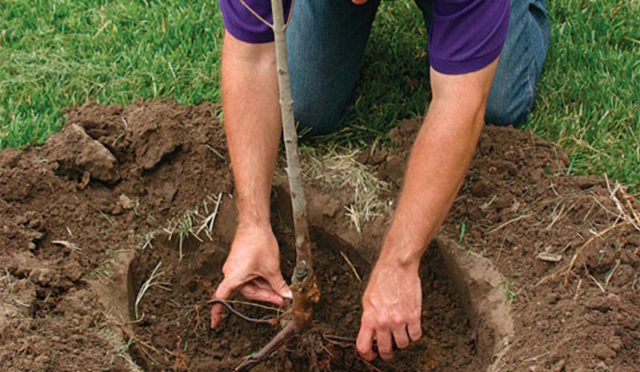
The root collar should rise 3-5 cm above ground level
To do this, young trees are fed with roots and bird droppings. The fertilizer is diluted according to the instructions on the package. On average, each seedling requires from 10 to 20 g of dry concentrate. If you plant cherries in the summer, you need to take care to protect the leaves and trunk from the scorching sun. Frail seedlings are covered with protective screens or special nets that scatter light.
How to plant cherries in the fall in the Urals
Despite the fact that autumn planting of seedlings in open ground is common in the central and southern regions, in the Ural climate it is quite problematic to plant cherries during this period. The main advantages of this approach are that the plant has prepared for winter, almost ceasing its life processes.
If it becomes necessary to plant cherries in the fall, it is better to do this in mid-September, after the remaining trees have given up their harvest and turn yellow. The planting hole is filled with prepared soil and the seedling is planted so that its root collar protrudes slightly above the ground.
Immediately after planting in open ground, it is necessary to take care of wintering. The tree trunk circles are covered with an increased layer of mulch. The trunk and branches of the seedling are insulated with spruce branches and roofing felt.Experienced gardeners advise installing additional protective screens from the wind for young trees.
Seedling care
Taking care of young trees will allow them to more easily survive the initial stages of life. The procedures for caring for cherries in the Urals are in most cases similar to those throughout the country. Early spring for crops is the time to apply organic and nitrogen fertilizers. Before the buds swell, urea and phosphorus bait are also added.
Every spring it is necessary to perform formative pruning of young trees. This will allow you to form a dense crown in the future. In addition, thinning eliminates the development of fungal diseases.
Also in the spring, seedlings are treated against insects. Preventive procedures are carried out at the moment the first leaves appear. To do this, a single spraying with insecticides or copper sulfate is sufficient. You can also include fungicidal preparations in preventive treatment - they will protect the cherries from fungi and harmful bacteria.
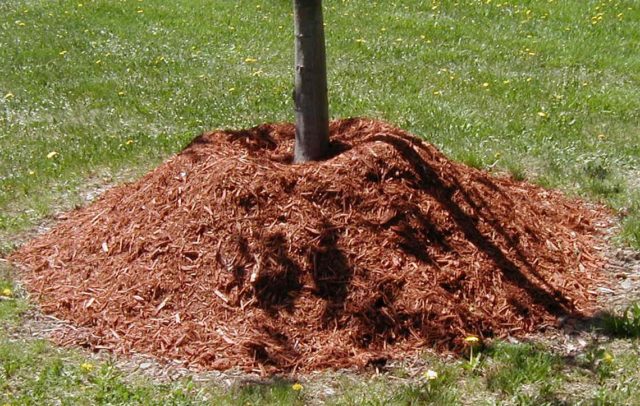
Before wintering, tree trunk circles are insulated with an additional layer of mulch
In the summer, the seedling must be provided with sufficient watering and protected from drought and sunburn. Irrigation should occur every 2-3 weeks with a certain amount of water. Also during this period, organic fertilizers are applied twice with an interval of 1 month.
After each harvest, cherries are prepared for the harsh Ural winter. First, sanitary pruning is carried out, removing damaged shoots. Before the first snow, the crown is insulated with roofing felt and spruce branches. Tree trunk circles are generously mulched with peat or sawdust.The better the tree is insulated, the greater the chances of young cherries to survive the winter in the Urals.
Advice from experienced gardeners
An important point when growing cherries in the Urals is the correct application of fertilizers. On average, up to 3 kg of organic bait is added to each square meter of tree trunk circle. Also a classic additive is 30 g of potassium chloride and 50 g of superphosphate.
An excellent way to regulate soil acidity is ash and bird droppings. 300 g of litter and 200 g of ash are diluted in a 20 liter container. Exactly half of the resulting volume is poured under each tree. With this fertilizer, you can refrain from complex chemical fertilizers in the first 3-4 years of the cherry’s life.
Experts advise not to neglect whitewashing the tree trunk. Summer in the Urals can be very hot. The sun can easily cause a serious burn to a young seedling and even an adult cherry. The height of the whitewash should reach the first branches, but be at least 80 cm.
Conclusion
Properly planting cherries in the spring in the Urals is a real science that requires strict adherence to all agricultural techniques. A healthy tree, enjoying abundant harvests, needs constant fertilization and insulation before the cold winter period.
